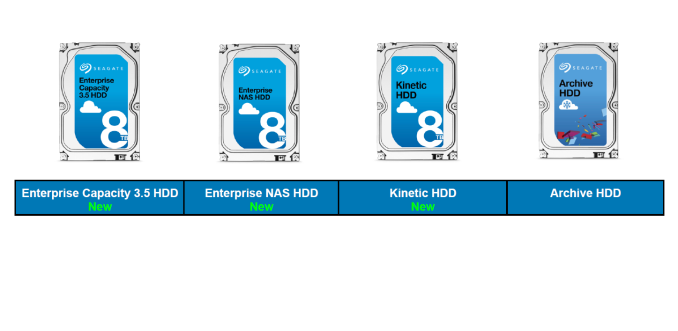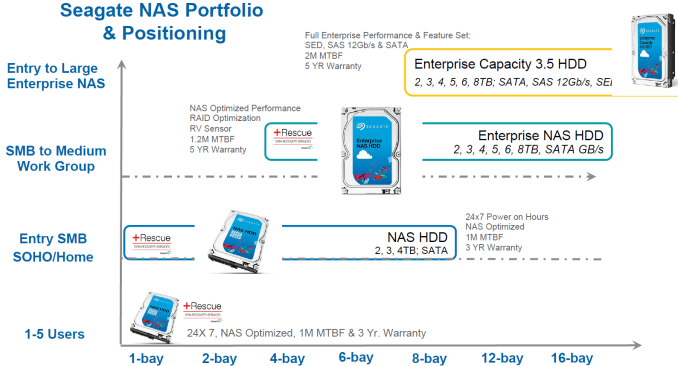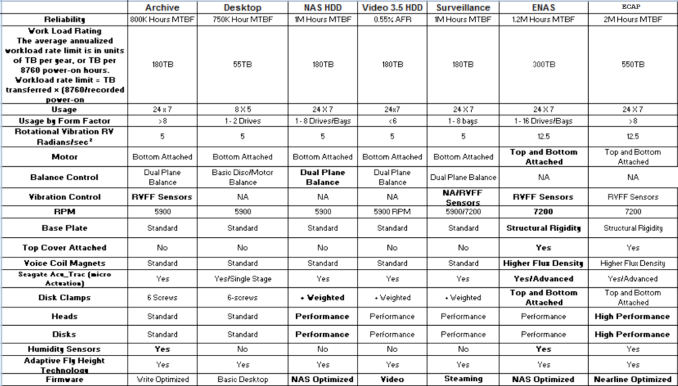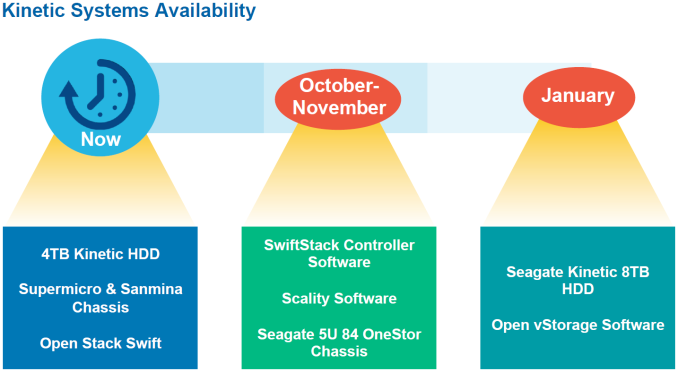Seagate Announces a Trio of 8TB Drives for Enterprise Applications
by Ganesh T S on September 1, 2015 8:00 AM EST
Seagate was the first hard drive vendor to launch a cost-effective 8TB hard drive. The Archive HDD v2 (ST8000AS0002) uses Shingled Magnetic Recording (SMR) to drive up the areal density of the platters and the 8TB version used six 1.33TB platters. The only other 8TB drive currently in the market is the HGST Ultrastar He8, which uses helium filled sealed drives with seven platters.
Seagate is announcing their plans for three new 8TB drives today, mainly targeting enterprise usage. The three 8TB models that join the already existing Archive HDD are:
- Enterprise Capacity 3.5 HDD v5
- Enterprise NAS HDD
- Kinetic HDD
The Enterprise Capacity 3.5 HDD v5 uses traditional PMR (perpendicular magnetic recording) and targets applications such as web, e-mail and SMB servers as well as areas requiring bulk storage. The design uses 6 platters (1.33TB/platter) pointing to an increase in areal density over competing drives. Thanks to the 256MB cache, it provides 100%+ faster random read-writes over the last generation Enterprise Capacity 3.5 HDD v4.
It comes in both SATA 6 Gbps and SAS 12 Gbps versions, and supports Seagate's RAID Rebuild (PDF) feature.
Consistent with the enterprise positioning, we also have a SED (self-encrypting drive) variant.
The other interesting aspects of the Enterprise Capacity 3.5 HDD v5 include power loss protection (needed in part due to the larger cache) and a PowerBalance feature. The latter offers optional trade-off in performance for saving power. However, the firmware programming necessary to activate this feature will be made available only to OEMs and not small scale end customers.
The Enterprise NAS HDD family is also getting the capacity boost to 8TB. The target market is medium to large business customers with requirements for 24x7 enterprise-class storage for mid-range NAS, RAID and cloud applications. This is the same target segment as before (1-16 bay tower / rackmount enclosures). The power consumption of the Enterprise NAS HDD is lower than the corresponding nearline drives. The Enterprise NAS HDD comes with a 5-year optional 'Rescue Data Recovery' service that was discussed in our coverage of the Enterprise NAS HDD launch last year. Like the Enterprise Capacity HDD v5, the Enterprise NAS HDD 8TB version is also based on PMR / 1.33TB/platter technology.
The MTBF, workload ratings and other important characteristics of the various drives offered by Seagate are summarized in the table below.
I had already talked about Kinetic HDDs in our coverage of Seagate at CES 2015. As a recap, the Kinetic HDDs do away with the need for a separate NAS server by presenting two Ethernet links over what looks like a SATA connector. Seagate is sharing some updates today regarding the Kinetic lineup. It is important to note that Kinetic is not a Seagate-only initiative, as Toshiba has also pledged support as a drive vendor for this ecosystem.
As part of the updates, Seagate shared the planned release of the Kinetic OneStor, a 5U 84-bay storage pod, in November this year. In January 2016, the Kinetic HDD 8TB will launch. Unlike the other two 8TB drives being announced today, the Kinetic HDD 8TB will be based on SMR technology.
The two PMR 8TB drives will be available towards the end of October. Seagate did not disclose any pricing information.














14 Comments
View All Comments
Guspaz - Tuesday, September 1, 2015 - link
So the Kinetic drives are internal hard disks with ethernet support built in? What is the use case for that? There isn't much of a market for a single-drive NAS, and the only thing I could see this drive enabling is cheaper single-drive NAS chassis.takeshi7 - Tuesday, September 1, 2015 - link
Kinetic drives are meant for large scale object storage datacenters. The idea is that you can fill the server enclosure entirely with drives, with no need for a server motherboard/RAID cards to take up valuable space/money.qasdfdsaq - Tuesday, September 1, 2015 - link
Indeed, large-scale object based storage is exactly what these are for, and 1Gbps switched Ethernet fabrics are far far cheaper than 6/12Gbps SATA/SAS expander/multipliers. Nothing to do with single-drive NAS.ganeshts - Tuesday, September 1, 2015 - link
Exactly, as Seagate likes to put it - isolation of storage from compute.Traditional NAS / SAN tends to put the drives in 'compute servers' - so scaling the performance is a matter of putting in more powerful platforms - think of Atom-based NAS vs. Core-based NAS vs. Xeon-based NAS. With the Kinetic drives, the compute part and the drives / storage are separate - you can scale either depending on your needs.
3DoubleD - Tuesday, September 1, 2015 - link
That is really interesting. Can you still perform the same types of software raid solutions that you could with SATA drives? Being limited to 1 gbps would not be incredibly limiting for my home server, parity checks and disk rebuilds never exceed ~90 MB/s. File copies off server are already limited by 1 gbps.... so no problem there. Ethernet switches are hell of a lot cheaper than SATA cards.ganeshts - Tuesday, September 1, 2015 - link
It needs special software support from the compute side.. something like SwiftStack - basically deal with object-based storage instead of traditional file systems.iwod - Tuesday, September 1, 2015 - link
So this is like Software Defined Storage? Basically moving the Controller and Raid to Software and CPU?I wonder what the cable looks like? And if the HDD are powered through the same cable?
What File System is best suited for this?
Power Efficiency ?
nils_ - Monday, September 7, 2015 - link
You'd use specialized software like Hadoop/HDFS or Ceph. Replication/Erasure Coding is then handled at the object level, as well as things like checksums etc. Obviously with disk sizes like this traditional block based RAID would yield pretty bad rebuild times otherwise.DanNeely - Tuesday, September 1, 2015 - link
I'm still curious what level of computing power they have on board. Even if they're currently only being targeted at the data-center; a single drive fileshare only NAS seems like an obvious future application for the tech. Unlike a media server/transcoder just serving up files wouldn't require much processing power.jhh - Tuesday, September 1, 2015 - link
Aside from the limitations of SMR, the Swift API uses http transport to transfer files, not your typical network filesystem protocol. The interface is also intended to read or write the entire file (or a very large chunk of a huge file). So, it's a good match for a media server backend, but not for random write applications. The Swift API is actually a good match for SMR technology. While I'm familiar with the Swift API, I'm not sure how the software is partitioned between the clients, the drives, and any required central permissions/index repository. Different partitioning leads to different implementation challenges.